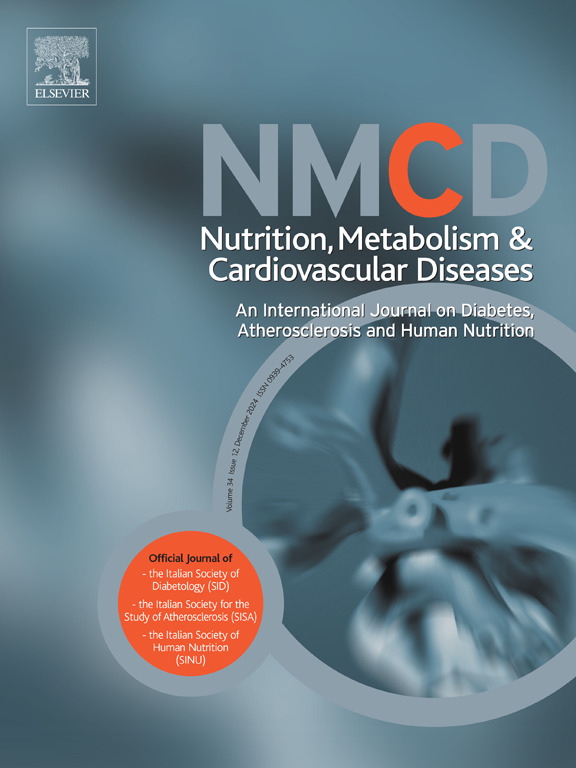NT-proBNP在心血管高危人群中的分布特点及筛查参考价值。
IF 3.7
3区 医学
Q2 CARDIAC & CARDIOVASCULAR SYSTEMS
Nutrition Metabolism and Cardiovascular Diseases
Pub Date : 2025-04-08
DOI:10.1016/j.numecd.2025.104029
引用次数: 0
摘要
背景与目的:n端前b型利钠肽(NT-proBNP)是评估心功能和血流动力学应激的关键生物标志物。然而,临床指南对其在心力衰竭(HF)风险人群(包括高血压、糖尿病或血脂异常患者)中的应用缺乏明确的建议。本研究旨在描述hf易感个体NT-proBNP水平的分布特征,并建立特定人群的筛查阈值。方法和结果:对三个队列进行横断面分析:2421例HF危险因素(高血压、糖尿病或血脂异常)患者,625例充血性HF患者和833例健康对照。NT-proBNP水平根据已建立的指南按心血管风险类别分层。采用受试者工作特征(ROC)曲线确定最佳筛选阈值。主要发现包括:结论:NT-proBNP水平可有效反映hf易感人群的心血管风险分层。采用风险分层参考值(106.0-116.7 pg/mL vs.健康成人124.6 pg/mL)可加强早期心衰检测和个性化风险管理。本文章由计算机程序翻译,如有差异,请以英文原文为准。
Distribution characteristics and screening reference values of NT-proBNP in high cardiovascular risk population
Background and aim
N-terminal pro B-type natriuretic peptide (NT-proBNP) is a key biomarker for assessing cardiac function and hemodynamic stress. However, clinical guidelines lack clear recommendations on its utility in populations at risk of heart failure (HF), including those with hypertension, diabetes, or dyslipidemia. This study aimed to characterize the distribution of NT-proBNP levels in HF-prone individuals and establish population-specific screening thresholds.
Methods and results
A cross-sectional analysis was conducted across three cohorts: 2421 patients with HF risk factors (hypertension, diabetes, or dyslipidemia), 625 patients with congestive HF, and 833 healthy controls. NT-proBNP levels were stratified by cardiovascular risk categories based on established guidelines. Receiver operating characteristic (ROC) curves were used to determine optimal screening thresholds. Key findings included.
Conclusions
NT-proBNP levels effectively mirror cardiovascular risk stratification in HF-susceptible populations. Adopting risk-stratified reference values (106.0–116.7 pg/mL vs. 124.6 pg/mL in healthy adults) may enhance early HF detection and personalized risk management.
求助全文
通过发布文献求助,成功后即可免费获取论文全文。
去求助
来源期刊
CiteScore
6.80
自引率
2.60%
发文量
332
审稿时长
57 days
期刊介绍:
Nutrition, Metabolism & Cardiovascular Diseases is a forum designed to focus on the powerful interplay between nutritional and metabolic alterations, and cardiovascular disorders. It aims to be a highly qualified tool to help refine strategies against the nutrition-related epidemics of metabolic and cardiovascular diseases. By presenting original clinical and experimental findings, it introduces readers and authors into a rapidly developing area of clinical and preventive medicine, including also vascular biology. Of particular concern are the origins, the mechanisms and the means to prevent and control diabetes, atherosclerosis, hypertension, and other nutrition-related diseases.

 求助内容:
求助内容: 应助结果提醒方式:
应助结果提醒方式:


